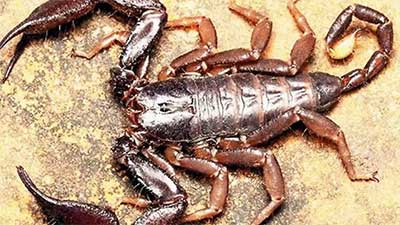Western ghat , a biodiversity hotspot and a unesco heritage site is known for its rich flora and fauna . We see discovery of new species of wild animal and plants in this area frequently. Recently , Thackeray Wildlife Foundation' reserchers discovered A new species of scorpion — belonging to genus chiromachetes.
This new species is endemic to the agasthyamalai mountain range in the western ghats. Thats why This species has been named chiromachetes agasthyamalaiensis.
The new species can be easily distinguished from all five known congeners by combination of non-overlapping morphological characters such as chela length-width ratio, femur length-width ratio, chela length-movable finger length ratio, the number of pectinal teeth, and subtle colour differences of both the sexes.
About agasthyamalai biosphere Reserve :
Located in the Western Ghats in the south of the country, the Agasthyamala Biosphere Reserve has peaks reaching 1,868 m above sea level.
Consisting mostly of tropical forest, the site is home to 2,254 species of higher plants including about 400 that are endemic. It is also a unique genetic reservoir of cultivated plants, in particular cardamom, jamune, nutmeg, pepper and plantain.
Three wildlife sanctuaries, Shendurney, Peppara and Neyyar, are located in the site, as well as the Kalakad Mundanthurai Tiger reserve.
A number of tribal settlements comprising a total population of 3,000 inhabit the biosphere reserve. They rely largely on biological resources for their sustenance, although recent projects have been set up to reduce their dependence on the forests.
About Western Ghat :
Older than the Himalaya mountains, the mountain chain of the Western Ghats represents geomorphic features of immense importance with unique biophysical and ecological processes.
A chain of mountains running parallel to India’s western coast, approximately 30-50 km inland, the Ghats traverse the States of Kerala, Tamil Nadu, Karnataka, Goa, Maharashtra and Gujarat. These mountains cover an area of around 140,000 km² in a 1,600 km long stretch that is interrupted only by the 30 km Palghat Gap at around 11°N.
The site’s high montane forest ecosystems influence the Indian monsoon weather pattern. Moderating the tropical climate of the region, the site presents one of the best examples of the monsoon system on the planet. It also has an exceptionally high level of biological diversity and endemism and is recognized as one of the world’s eight ‘hottest hotspots’ of biological diversity. The forests of the site include some of the best representatives of non-equatorial tropical evergreen forests anywhere and are home to at least 325 globally threatened flora, fauna, bird, amphibian, reptile and fish species.







